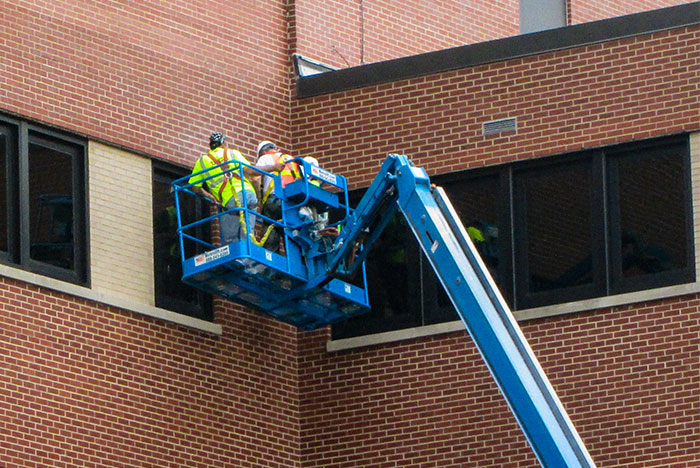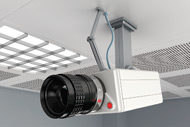
A facility condition assessment team inspects the building's exterior and windows.
Leaders and staff of Veterans Administration (VA) facilities are extraordinarily dedicated and committed to their mission. They put their hearts and souls into serving the health care needs of Veterans and the facilities that support this care delivery.
This passion explains how much they rely on consultants to help monitor the effectiveness and safety of their facilities. In a facility condition assessment (FCA), a team of trained industry professionals — typically architects and engineers — analyzes the condition of a facility and prepares recommendations that may include remediation or replacement of one or more structures. Like other organizations, the VA uses the FCA to justify, prioritize and secure funding for capital improvement projects.
A VA medical center may include residential units previously used as officer quarters, patient housing, administration buildings, facilities for various support functions and specialized clinics. Any of these may benefit from the analysis generated by an FCA.
Who Needs an FCA?
Any organization with capital assets needs to maintain those facilities in a safe and cost-effective manner. The FCA process allows these organizations to prioritize and schedule necessary maintenance. If they wait to react to problems after they become obvious, it is usually too late to implement cost-effective remediation. What might have been a $50,000 remediation project becomes a $5 million or more replacement project. A client may also use an FCA to assess a facility that it intends to acquire.
An FCA is analogous to an annual physical but, for a hospital, the economic context adds urgency. In the last seven years, developments such as the Affordable Care Act have affected what money is available for repairs and new facilities.
Facilities are run differently depending on their size, staff and geographical location. An independent outlook justifies their needs better and gives them a consistent approach over multiple facilities. Some buildings have been aging since the 1800s, and it's hard to modernize an old building. A rural community hospital in the Midwest dating to the 1940s was not compatible with modern equipment and practices. Its floor-to-ceiling heights were too low. Oculus’ project team conducted an FCA for renovation and an addition. However, comparing the renovation cost of $18 million with the $23 million price tag for a new facility made it easy to opt for the latter.
In a VA context, an FCA can identify and prioritize issues throughout an entire VA system that may encompass multiple locations in a state. Oculus’ project team establishes a baseline for them, using criteria provided by the VA. The consultants can judge facilities consistently over multiple locations, thereby yielding a more consistent assessment on a VA-wide basis. In the last four years, the project team has conducted surveys at seven Veterans Integrated Service Networks (VISN), all over the country. The survey covered 1,500 buildings and approximately 39.5 million total square feet.
It is important to balance the cost of deficiencies against the cost of building remediation or replacement. By creating a smart perspective, the FCA team can head off overly reactionary responses down the road. For example, it may make more sense to repair something now than replace it if the entire building will be replaced next year.
The VA uses FCAs in a layering process, starting at the 30,000-foot level to identify the overarching issues. Then it takes that information and either does a more detailed investigation — such as spot inspections, code analysis, safety inspections — or it sets out to tackle the problem.
During one FCA project, the team reviewed seismic requirements. Based on the number of occupants, the building needed a stronger seismic design than it had, so the team brought the issue to the leadership so it could plan an upgrade.
On a separate project, a renovation project for a VA lab in the Midwest, the FCA team was working to determine air-exhaust requirements. During that process, the team realized that there was no consensus about the load each area of the facility added to the exhaust system. When the team brought this concern to the contracting office representative, the VA staff determined that the project would fail because of the compounding problem and promptly addressed the concerns before it became a larger issue. In a hospital’s operating suite, if the ductwork is undersized or worn or if ventilation and incoming air are not meeting temperature requirements, it poses a problem for surgery and may render the suite unusable.
Gathering information
As soon as possible, obtain access to any documentation and drawings from the most recent FCA. Many medical centers have a three-year assessment cycle. After confirming the previous FCA, the team can find other deficiencies that are new or were not addressed in the previous assessment.
To ensure accuracy and fairness, talk with the engineers. Interviewwing staff at all levels to round out the information gained from leadership ensures that the assessment team won’t be led astray by one personal view. Then weigh these factors to compile a list of deficiencies. It’s important to obtain data about specific items as well as systemwide data. For example, inadequate windows can overheat rooms, overloading the ventilation and air distribution.
Assembling the team
The FCA process can be customized to accommodate the end goals of the organization. An FCA team should include one or two architects, a mechanical engineer, an electrical engineer, a structural engineer, a vertical transportation consultant and a cost estimator. In some projects, there is a need for civil engineers, security consultants, architectural historians, environmental experts and others, depending on the existing condition of various elements within the campus. Before assembling the team, it is important to know the desired outcome of the survey. As they work, the team members compare and contrast their observations to raise issues another surveyor may have missed.
When selecting an FCA team, make sure they can demonstrate practical experience with medical facility design and other institutional work. They should know how to put a building together and what deficiencies to look for. Latent and failing conditions often are not visible at first sight, but by knowing what questions to ask and following up, the team determines where the issues are.
Establishing priorities
The FCA team begins by establishing priorities. This can be difficult when the project scope and budget conflict. From there, the engineers and architects work together to meet the medical center’s needs within the budgetary constraints, with safety issues taking top priority.
Redundant power, water and communication are necessary if a facility is designated as mission-critical. If there is a failure in one of these systems, the backup must take over. Infrastructure concerns include multiple entry and exit points at a facility. There must be an alternative way to access mission-critical facilities if emergency services cannot get through the main gate.
In addition to assessing the physical aspects of a facility, many clients must maintain accountability and stewardship of funds. The VA, for example, has used the FCA to prioritize needs, especially during the last several years, knowing that accurate FCAs can secure the changes they are seeking.
The Oculus project team uses a grading system to rate deficiencies and prioritizes which work to undertake and the order in which it should be done.
Maintain communication
When gathering data, always tap into the staff’s knowledge of the facility. They often will point the team in the right direction, saving time.
Communicate construction costs to the cost estimator. From the beginning, cost estimation must analyze several factors — the local economy, small or diverse contractors (minority- or woman-owned) and market fluctuations. The team may have determined a cost for a specific repair, but it must also account for ripple effects.
Maintain communication within the team to avoid statistical errors. Perform quality control and follow up to be as accurate as possible. To ensure client satisfaction, track comments and respond to them until all items are resolved.
Start with the end goal
Before embarking on an FCA, most facilities are already prepared for challenges, but they need to understand their level of exposure. Beyond that, they need direction following the assessment.
Over the long haul, they can track whether conditions are getting better and what the trends are. This knowledge is important for staff retention and preventing safety hazards and outages. The most important thing to remember is that, whichever team is chosen, it must always have a clear understanding of what it wants the FCA to accomplish before starting.
Marc Lopez is director at Oculus Inc. and can be reached at MarcL@oculusinc.com. Rob Forney is project manager at Oculus Inc. and can be reached at RobF@oculusinc.com.





